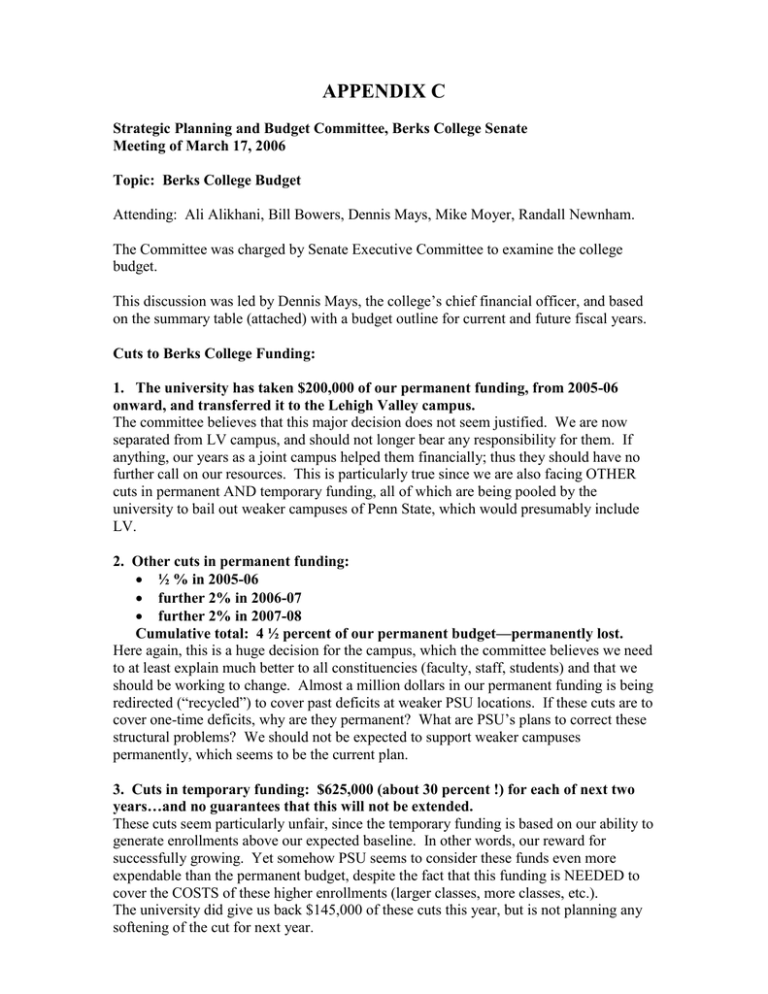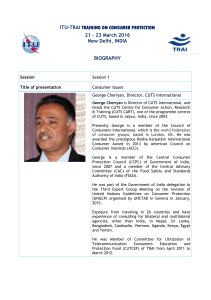Strategic Planning and Budget Committee Minutes for Friday, March 17, 2006
advertisement

APPENDIX C Strategic Planning and Budget Committee, Berks College Senate Meeting of March 17, 2006 Topic: Berks College Budget Attending: Ali Alikhani, Bill Bowers, Dennis Mays, Mike Moyer, Randall Newnham. The Committee was charged by Senate Executive Committee to examine the college budget. This discussion was led by Dennis Mays, the college’s chief financial officer, and based on the summary table (attached) with a budget outline for current and future fiscal years. Cuts to Berks College Funding: 1. The university has taken $200,000 of our permanent funding, from 2005-06 onward, and transferred it to the Lehigh Valley campus. The committee believes that this major decision does not seem justified. We are now separated from LV campus, and should not longer bear any responsibility for them. If anything, our years as a joint campus helped them financially; thus they should have no further call on our resources. This is particularly true since we are also facing OTHER cuts in permanent AND temporary funding, all of which are being pooled by the university to bail out weaker campuses of Penn State, which would presumably include LV. 2. Other cuts in permanent funding: ½ % in 2005-06 further 2% in 2006-07 further 2% in 2007-08 Cumulative total: 4 ½ percent of our permanent budget—permanently lost. Here again, this is a huge decision for the campus, which the committee believes we need to at least explain much better to all constituencies (faculty, staff, students) and that we should be working to change. Almost a million dollars in our permanent funding is being redirected (“recycled”) to cover past deficits at weaker PSU locations. If these cuts are to cover one-time deficits, why are they permanent? What are PSU’s plans to correct these structural problems? We should not be expected to support weaker campuses permanently, which seems to be the current plan. 3. Cuts in temporary funding: $625,000 (about 30 percent !) for each of next two years…and no guarantees that this will not be extended. These cuts seem particularly unfair, since the temporary funding is based on our ability to generate enrollments above our expected baseline. In other words, our reward for successfully growing. Yet somehow PSU seems to consider these funds even more expendable than the permanent budget, despite the fact that this funding is NEEDED to cover the COSTS of these higher enrollments (larger classes, more classes, etc.). The university did give us back $145,000 of these cuts this year, but is not planning any softening of the cut for next year. Other issues addressed at the meeting: 1. Possible changes to budget projection model. The model our college is using (see summary table) does not take many predictable factors into account. For example: A. On the income side, our permanent budget shows no growth for increased state appropriations or increased tuition. This gives a very pessimistic prognosis, since only cuts are included and not growth. This growth is somewhat unpredictable, but surely we can include our best prediction of these factors, based on recent history. University Park should have these numbers readily available; they must be using them in their own projections. B. Similarly, on the expenditure side, salaries and wages, by far the largest components of college spending, are simply projected to continue at exactly the same level into the future, without accounting for inflation or expected new hires. Yet other components (dept. allotments, for example) are projected to increase over time. C. College income from grants and fundraising is simply not included, although that is an important source of income. Again, projecting this into the future is difficult, but it is hard to have an accurate budget estimate without it. D. No spending is shown for the new building or other future capital projects, although we are supposed to be starting them during the time of the projection. The committee recommends that we contact University Park and see how their budget predictions are made, and that we harmonize our methods to reflect theirs, which likely include these more detailed models. Future meetings: The committee has now completed all of the tasks assigned to it by the Senate Council, and does not envision further meetings this year.


